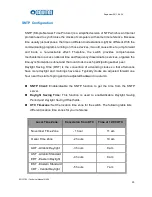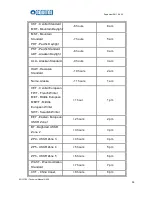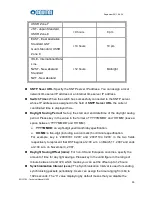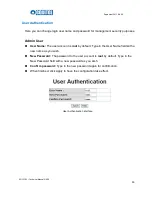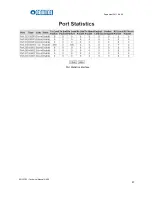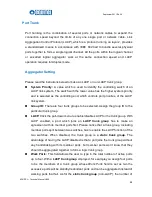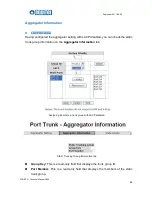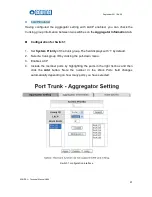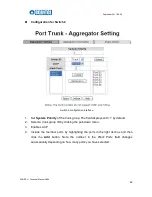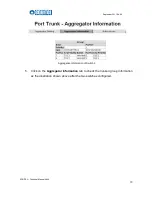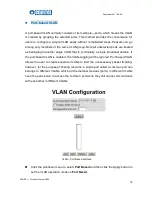
September 2011 Ed.2.0
EQUITEL – Technical Manual N968
64
Port Trunk
Port trunking is the combination of several ports or network cables to expand the
connection speed beyond the limits of any one single port or network cable. Link
Aggregation Control Protocol (LACP), which is a protocol running on layer 2, provides
a standardized means in accordance with IEEE 802.3ad to bundle several physical
ports together to form a single logical channel. All the ports within the logical channel
or so-called logical aggregator work at the same connection speed and LACP
operation requires full-duplex mode.
Aggregator Setting
Please read the instrutions below to make an LACP or non-LACP trunk group.
System Priority:
A value which is used to identify the controlling switch of an
LACP link system. The switch with the lower value has the higher system priority
and is selected as the controlling end, which controls port priorities, of the LACP
link system.
Group ID:
There are four trunk groups to be selected. Assign the group ID to the
particular trunk group.
LACP:
Click the pull-down menu to enable/disable LACP for the trunk group. With
LACP enabled, a port which joins an
LACP trunk group
has to make an
agreement with its member ports first. Please notice that a trunk group, including
member ports split between two switches, has to enable the LACP function of the
two switches. When disabled, the trunk group is a
static trunk group
. The
advantage of having the LACP disabled is that a port joins the trunk group without
any handshaking with its member ports; but member ports won’t know that they
should be aggregated together to form a logic trunk group.
Work Ports:
This field allows the user to type in the total number of active ports
up to four. With a
LACP trunk group
employed, for example you assign four ports
to be the members of a trunk group whose
Work Ports
field is set as two the
excessive ports will be standby/redundant ports and can be aggregated instead of
working ports that fail. As for the
static trunk group
(non-LACP), the number of
Summary of Contents for N968
Page 7: ...September 2011 Ed 2 0 EQUITEL Technical Manual N968 IPv6 Commands Set 148 ...
Page 19: ...September 2011 Ed 2 0 EQUITEL Technical Manual N968 12 Crossover Cable Schema ...
Page 25: ...September 2011 Ed 2 0 EQUITEL Technical Manual N968 18 ...
Page 54: ...September 2011 Ed 2 0 EQUITEL Technical Manual N968 47 Syslog Configuration interface ...
Page 56: ...September 2011 Ed 2 0 EQUITEL Technical Manual N968 49 SMTP Configuration interface ...
Page 58: ...September 2011 Ed 2 0 EQUITEL Technical Manual N968 51 Event Configuration interface ...
Page 65: ...September 2011 Ed 2 0 EQUITEL Technical Manual N968 58 IP Security interface ...
Page 68: ...September 2011 Ed 2 0 EQUITEL Technical Manual N968 61 Port Statistics interface ...
Page 70: ...September 2011 Ed 2 0 EQUITEL Technical Manual N968 63 Port Control interface ...
Page 79: ...September 2011 Ed 2 0 EQUITEL Technical Manual N968 72 State Activity of Switch 2 ...
Page 96: ...September 2011 Ed 2 0 EQUITEL Technical Manual N968 89 RSTP System Configuration interface ...
Page 98: ...September 2011 Ed 2 0 EQUITEL Technical Manual N968 91 RSTP Port Configuration interface ...
Page 100: ...September 2011 Ed 2 0 EQUITEL Technical Manual N968 93 SNMP System Configuration interface ...
Page 113: ...September 2011 Ed 2 0 EQUITEL Technical Manual N968 106 802 1x System Configuration interface ...
Page 117: ...September 2011 Ed 2 0 EQUITEL Technical Manual N968 110 Static MAC Addresses interface ...




